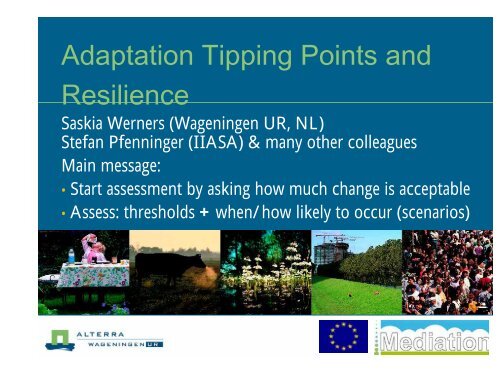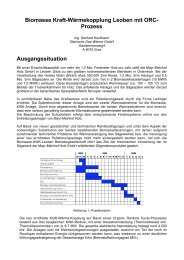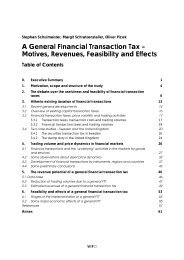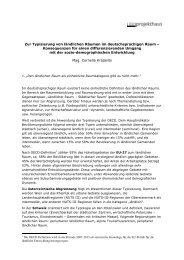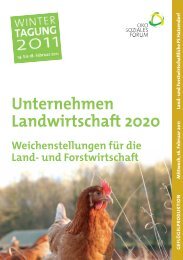Adaptation Tipping Points and Resilience
Adaptation Tipping Points and Resilience
Adaptation Tipping Points and Resilience
Create successful ePaper yourself
Turn your PDF publications into a flip-book with our unique Google optimized e-Paper software.
<strong>Adaptation</strong> <strong>Tipping</strong> <strong>Points</strong> <strong>and</strong><br />
<strong>Resilience</strong><br />
Saskia Werners (Wageningen UR, NL)<br />
Stefan Pfenninger (IIASA) & many other colleagues<br />
Main message:<br />
• Start assessment by asking how much change is acceptable<br />
• Assess: thresholds + when/how likely to occur (scenarios)
Experiment
Experiment
Today<br />
Illustrate challenge for climate impact <strong>and</strong> vulnerability<br />
assessment<br />
Propose for assessment: ‘adaptation tipping points’<br />
Link to resilience discussion & future work<br />
Work in progress: ! your feedback much appreciated !<br />
Amsterdam<br />
Januari 2008
Illustrations – Delta Programme (Long term (2100) water safety,<br />
fresh water supply. Capitalise on opportunities water offers)<br />
Deltacommissioner Wim Kuijken (29 Sept.2010):<br />
One of the biggest challenges is dealing with uncertainties in the<br />
future climate, but also in population, economy <strong>and</strong> society. This<br />
One requires of the a new biggest way challenges of planning, is dealing which we with call uncertainties adaptive delta in the<br />
future planning. climate, It seeks but also to maximise in population, economy <strong>and</strong> society. This<br />
requires flexibility; a keeping new way options of planning, open which we call adaptive delta<br />
planning. <strong>and</strong> avoiding It seeks lock-in. to maximise flexibility; keeping options open<br />
In <strong>and</strong> the avoiding meantime, lock-in. we prepare In the the meantime, we prepare the so-called<br />
so-called delta decisions delta decisions about the about measures to take if our current water<br />
the system measures reaches to its take limits. if our current<br />
water system reaches its limits.<br />
Base values:<br />
• Solidarity<br />
• Flexibility<br />
• Sustainability
Source: Deltares
Assessment of ‘adaptation tipping points’<br />
Why:<br />
Climate change becomes relevant to policy makers if it threatens current policy<br />
objectives or results in conditions that society perceives as undesirable.<br />
If such a situation is thinkable, next to knowing the extent of the threat, at<br />
least equally important is to know when <strong>and</strong> how likely it is.<br />
The question is how much longer current policies <strong>and</strong> management are<br />
expected to suffice <strong>and</strong> when adjustments will be required. In other words,<br />
when are tipping points in the socio-political system reached?<br />
<strong>Adaptation</strong> tipping points:<br />
a situation where a socio-political threshold is reached, due to<br />
climate change induced changes in the bio-physical system.<br />
Socio-political thresholds:<br />
• formal policy objectives<br />
• informal societal preferences, willingness to invest/protect cultural identity
<strong>Tipping</strong> points <strong>and</strong> adaptation<br />
Korte<br />
Short term<br />
termijn<br />
measures ingrepen<br />
Major Grote Major “Grote<br />
Ingrepen interv. Ingrepen”<br />
intervention<br />
Available robustness <strong>and</strong> flexibility<br />
Beschikbare robuustheid en flexib. (RO)<br />
Benodigde robuustheid en flexib. (KV)<br />
Robustness<br />
Robuustheid<br />
Flexibility Flexibiliteit<br />
Mitigatie<br />
Required robustness <strong>and</strong> flexibility<br />
<strong>Tipping</strong> Omslagpunt Point<br />
<strong>Tipping</strong> Omslagpunt Point<br />
Time Tijd
Assessment of adaptation tipping points<br />
Ask: What are socio-political objectives (non-climate)?<br />
Select indicators <strong>and</strong> threshold values for impacts on sectors &<br />
regions: determine what situation is acceptable according to:<br />
• Analysis of policy objectives / st<strong>and</strong>ards / administrative<br />
arrangements<br />
• Public opinion, <strong>and</strong>/or<br />
• Statistics<br />
Danube Basin (ICPDR reports), e.g.:<br />
• Risk categories:<br />
Organic pollution, Hazardous substances, Nutrient pollution,<br />
Hydro-morphological alterations, Flood frequency<br />
• Loss of biodiversity / fish stock
Assessment of adaptation tipping points<br />
Determine adaptation tipping points: how much change sectors can h<strong>and</strong>le,<br />
given the thresholds value (independent from time) Ask: What climate<br />
conditions are critical for objectives? What are threshold conditions<br />
for reaching objectives (beyond which current strategy fails)<br />
Methods: compare with design criteria; consult experts / representatives from<br />
different sectors; assess historical variation of boundary conditions. System<br />
analysis linking climate conditions to the thresholds. Modelling effect of<br />
stepwise increasing climate conditions.<br />
Nature goals not reached<br />
Inlet fresh water too often too salt (Gouda)<br />
Design criteria storm surge barrier exceeded<br />
Storm surge barrier closed too frequent for port<br />
S<strong>and</strong> suppletion fails to meet coastal erosion<br />
Energy supply fails due to limits cooling capacity<br />
Tulip Norms fields for flood affected levees by not salinity met groundwater<br />
Note: Alternative presentation e.g.<br />
traffic light bar<br />
<strong>Tipping</strong> points for Rijnmond region (red dots). Green line: no tipping point (Jeuken et al., 2010).
Assessment of adaptation tipping points<br />
Translate tipping points to timescale: Use existing scenario (eg IPCC, or from<br />
national agencies) to assess when tipping points are likely to occur.<br />
Methods: use climate scenario’s, extreme/moderate (depends on sector);<br />
interpolate between projection year <strong>and</strong> now; express uncertainty earliest<br />
date/ latest date that climate change will have reached a certain value<br />
Nature goals not reached<br />
Inlet fresh water too often too salt (Gouda)<br />
Design criteria storm surge barrier exceeded<br />
Storm surge barrier closed too frequent for port<br />
S<strong>and</strong> suppletion fails to meet coastal erosion<br />
Energy supply fails due to limits cooling capacity<br />
Norms for flood levees not met
Assessment of adaptation tipping points<br />
Determine decision tree & adaptation pathways: Repeat 4 & 5 for these<br />
alternatives + assess how easy it is to switch in time (flexibility/‘no regret’)
Assessment of adaptation tipping points<br />
Determine alternative adaptation strategies: assess how to implement a<br />
different strategy or additional measures to postpone / resolve a tipping<br />
point (methods depend on scale, score these alternatives to policy targets)<br />
<strong>Adaptation</strong> pathways for the<br />
Theems estuary with<br />
increasing sea level<br />
The blue boxes are<br />
adaptation strategies<br />
(portfolios of option)<br />
The blue arrows show<br />
possibly transitions between<br />
strategies.<br />
In red the various scenarios<br />
(EnvironmentAgency, 2007)
Research objective<br />
The scientific objective is to gain a better underst<strong>and</strong>ing of the<br />
role of tipping points in adaptation to climate change <strong>and</strong> to<br />
elaborate the possibility <strong>and</strong> consequences of using adaptation<br />
tipping points for the identification of structural properties <strong>and</strong><br />
mechanisms that make socio-ecological systems robust <strong>and</strong>/or<br />
receptive to shocks to external shocks or internal perturbations<br />
The practical objective is to explore whether adaptation tipping<br />
points are a useful concept for assessing <strong>and</strong> communicating the<br />
implications of climate change, which can help decision makers<br />
in developing <strong>and</strong> prioritising adaptation strategies<br />
The adaptation tipping point perspective is chosen because it is<br />
appears a timely concept for bringing together concerns /<br />
insights about how much stress a system can absorb before<br />
losing its function <strong>and</strong> when this is likely to happen.
Central research questions<br />
Can adaptation tipping points be defined in such a way that they<br />
are an appropriate concept for assessing <strong>and</strong> communicating the<br />
implication of climate change & prioritise adaptation strategies?<br />
If so, how do these adaptation tipping points emerge? And<br />
(how) have the actions of agents contributed to adaptation<br />
tipping points?<br />
How to identify adaptation tipping points?<br />
What are possible responses to adaptation tipping points?<br />
What are consequences of working with adaptation tipping<br />
points for decision support?<br />
When do adaptation tipping points become decision tipping<br />
points, where management of socio-ecological systems shifts?
Conclusions / Experience<br />
Question: Can adaptation tipping points be defined in such a way that<br />
they are appropriate concept for assessing <strong>and</strong> communicating the<br />
implication of climate change & prioritise adaptation strategies?<br />
• Closer to the question of policy maker/manager/ stakeholder<br />
•<br />
•<br />
•<br />
Allows for dialogue between scientific & policy community.<br />
Expressing uncertainty in time (when will a critical point be<br />
reached) is easier to underst<strong>and</strong> than % change in a certain<br />
projection year<br />
Some times far from trivial<br />
(not the silver bullet) because……
Our water<br />
system is<br />
very<br />
resilient!”
Thanks! & Discussion<br />
Contact: werners@mungo.nl saskia.werners@mungo.nl
Discussion: what you like / dislike about adaptation tipping points<br />
suggestions comments:<br />
- few governments have foresight to be concerned<br />
- real concern about long run problems<br />
- how to measure tipping points & deal with long horizon<br />
- nature of tipping point / threshold not very precise: scale <strong>and</strong><br />
- definition: conceptual background?<br />
- change / transformation in policy<br />
- physical / policy proces analysed? what tipping points<br />
- plurality different types of coupled systems. typing points are dynamic in time<br />
- developng country context? tipping points already reached?<br />
- note: tolerable risk community
Extras
<strong>Adaptation</strong> tipping points<br />
Assess:<br />
• What are socio-political objectives [e.g. in policy docs]?<br />
• Are objectives currently met?<br />
• Are What climate conditions are critical for objectives?<br />
• What are threshold conditions for reaching objectives (tipping<br />
points)<br />
• When are thresholds reached according to various climate<br />
scenarios?<br />
• What are adaptive responses / alternative measures<br />
(Kwadijk, 2010)
Assessment of adaptation tipping points<br />
1. Scoping the assessment: make a long list of possible consequences of<br />
climate change for a region or sectors<br />
2. Prioritise climate change trends <strong>and</strong> impacts: From long list to short list.<br />
Select impacts based on potential severity <strong>and</strong> likeliness (e.g. build urgency<br />
matrix (use trends + extreme scenarios))<br />
3. Select indicators <strong>and</strong> threshold values: determine what effects are<br />
acceptable according to: Analysis of policy objectives / st<strong>and</strong>ards /<br />
administrative arrangements, Public opinion, <strong>and</strong>/or Statistics<br />
4. Determine adaptation tipping points: how much change sectors can<br />
h<strong>and</strong>le, given the thresholds value (independent from time) (e.g. by system<br />
analysis linking climate conditions to the thresholds)<br />
5. Translate tipping points to timescale: Use existing scenario (eg IPCC, or<br />
from national agencies) to assess when tipping points are likely to occur<br />
6. Determine alternative adaptation strategies: assess how to implement a<br />
different strategy or additional measures to postpone / resolve a tipping<br />
point (methods depend on scale, score these alternatives to policy targets)<br />
7. Determine decision tree & adaptation pathways: Repeat 4 & 5 for these<br />
alternatives + assess how easy it is to switch in time (flexibility/‘no regret’)
Assessment of vuln. / adaptation tipping points<br />
1. Scoping the assessment: make a long list of possible consequences of<br />
climate change for a region or sectors<br />
Rows: Effects of climate change + scores of likelihood<br />
Columns: Impacts (on flood safety, fresh water supply, economic activities<br />
(navigation, drinking water, power production)+ scores of severity)
Assessment of adaptation tipping points<br />
2. Prioritise climate change trends <strong>and</strong> impacts: From long list to short list.<br />
Select impacts, sectors & regions based on potential severity <strong>and</strong> likeliness<br />
(e.g. build urgency matrix (use trends + extreme scenarios))<br />
When carried out with stakeholders provides commitment<br />
to those issues that need to be addressed
Assessment of adaptation tipping points<br />
6. Determine alternative adaptation strategies: assess how to implement a<br />
different strategy or additional measures to postpone / resolve a tipping<br />
point (methods depend on scale, score these alternatives to policy targets)
Many different approaches
Impact assessment / indicators / IPCC
Climate<strong>Adaptation</strong> Atlas: Maps, Traffic light
Storylines & development pathways (PBL)<br />
Semi-urban<br />
Multifunctional semi-urban agriculture Intensive agriculture<br />
Diversify Specialize /<br />
Multifunctional rural agriculture<br />
Large scale agriculture<br />
world market<br />
Rural
Integrale adaptatiestrategieën<br />
Urban<br />
Little competition /<br />
regional market<br />
Strong<br />
competition /<br />
world market<br />
Rural
<strong>Adaptation</strong> – addressing different drivers
Assessment questions<br />
What do we<br />
adapt to?<br />
How do we<br />
adapt?<br />
Enabling<br />
factors?<br />
Effectiveness<br />
of option?<br />
Climate<br />
adaptation<br />
What do we<br />
want to achieve?<br />
Who adapts?<br />
Whose goal?<br />
After: Preston (2010)
A combination…?
The vulnerability assessment approach<br />
Review of the suitability of existing typologies for<br />
ecosystems, based on:<br />
-EU Habitat <strong>and</strong> Birds Directives <strong>and</strong> Natura 2000 data base<br />
-Carpathian Biodiversity Information System<br />
-L<strong>and</strong> cover data for the Carpathian region<br />
-European <strong>and</strong> National Forest Inventories<br />
-Pan European Ecological Network (PEEN)<br />
-European Topic Center on Biological Diversity<br />
Selection of the suitable typology for ecosystems for input<br />
into the vulnerability assessment matrix<br />
Vulnerability assessment of the climate change threats for<br />
each ecosystem according to the selected typology


